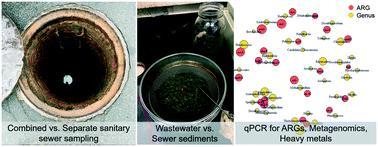当前位置:
X-MOL 学术
›
Environ. Sci.: Water Res. Technol.
›
论文详情
Our official English website, www.x-mol.net, welcomes your feedback! (Note: you will need to create a separate account there.)
Factors associated with elevated levels of antibiotic resistance genes in sewer sediments and wastewater
Environmental Science: Water Research & Technology ( IF 5 ) Pub Date : 2020-04-29 , DOI: 10.1039/d0ew00230e Eramo Alessia 1 , Morales Medina 2 , R William 2 , N L Fahrenfeld 1
Environmental Science: Water Research & Technology ( IF 5 ) Pub Date : 2020-04-29 , DOI: 10.1039/d0ew00230e Eramo Alessia 1 , Morales Medina 2 , R William 2 , N L Fahrenfeld 1
Affiliation

|
The sewer environment is a potential hotspot for the proliferation of antibiotic resistance genes (ARGs) and other hazardous microbial agents. Understanding the potential for ARG proliferation and retardation and/or accumulation in sewer sediments is of interest for protecting the health of sewage workers and the broader community in the event of sewer overflows as well as for interpreting sewage epidemiology data. To better understand this understudied environment for antibiotic resistance, a field survey was conducted to identify the factors that may control ARGs in sewer sediments and sewage. qPCR was performed for select ARGs and amplicon sequencing was performed for paired samples from combined and separate sanitary sewer systems. Metagenomic sequencing was performed on combined sewer sediments. The relative abundances of sul1, tet(O), tet(W), ermF, and vanA were higher in wastewater compared to sewer sediments, while NDM-1 was greater in sewer sediment and tet(G) was similar between the two matrices. NDM-1 was observed in sewer sediment but rarely above detection in wastewater in this study. This may indicate that larger/more frequent wastewater samples are needed for detection and/or that retardation and/or accumulation in sewage sediment may need to be considered when interpreting wastewater-based epidemiology data for ARGs. Random forest analyses indicated that season and conductivity were important variables and to a lesser extent so were pH, TSS, heavy metals, and sewer type for explaining the variance of the ARGs. These variables explained the 19–61% of the variance of sul1, tet(O), tet(G), and tet(W) quantified in wastewater. These variables performed less well for explaining the variance in sewer sediments (0.2–24%). Sewer sediment and wastewater had distinct microbial community structures and biomarkers for each are described. Metagenomics indicated that a high diversity of ARGs, including several of medical importance, was observed in the combined sewer sediment. This work provides insight into the complex sewer microbiome and the potential hazard posed by different sewer matrices.
中文翻译:

下水道沉淀物和废水中抗生素抗性基因水平升高的相关因素
下水道环境是抗生素抗性基因(ARG)和其他有害微生物制剂繁殖的潜在热点。了解下水道沉积物中ARG增殖和迟缓和/或积累的潜力,对于在下水道溢出的情况下保护下水道工人和广大社区的健康以及解释下水道流行病学数据十分重要。为了更好地了解这种对抗生素耐药性尚未充分研究的环境,进行了现场调查,以确定可能控制下水道沉积物和污水中的ARGs的因素。对选定的ARGs进行qPCR,对来自组合和分开的下水道系统的成对样品进行扩增子测序。对合并的下水道沉积物进行超基因组测序。的相对丰度sul 1,tet(O),tet(W),erm F和van A在废水中比下水道沉积物高,而NDM-1在下水道沉积物和tet中高(G)在两个矩阵之间相似。在这项研究中,在下水道沉积物中观察到NDM-1,但很少高于废水中的NDM-1。这可能表明在检测ARGs的基于废水的流行病学数据时,需要更大/更频繁的废水样本进行检测,和/或可能需要考虑污水沉积物中的滞后和/或积累。随机森林分析表明,季节和电导率是重要变量,在较小程度上,pH,TSS,重金属和下水道类型也可以用来解释ARGs的变化。这些变量说明了sul 1,tet(O),tet(G)和tet的方差的19–61%(W)在废水中定量。这些变量不能很好地解释下水道沉积物的变化(0.2-24%)。下水道沉积物和废水具有不同的微生物群落结构,并描述了每种生物标记物。元基因组学表明,在合并的下水道沉积物中观察到了ARGs的高度多样性,包括医学上的重要性。这项工作提供了对复杂的下水道微生物组以及不同下水道基质造成的潜在危害的见识。
更新日期:2020-04-29
中文翻译:

下水道沉淀物和废水中抗生素抗性基因水平升高的相关因素
下水道环境是抗生素抗性基因(ARG)和其他有害微生物制剂繁殖的潜在热点。了解下水道沉积物中ARG增殖和迟缓和/或积累的潜力,对于在下水道溢出的情况下保护下水道工人和广大社区的健康以及解释下水道流行病学数据十分重要。为了更好地了解这种对抗生素耐药性尚未充分研究的环境,进行了现场调查,以确定可能控制下水道沉积物和污水中的ARGs的因素。对选定的ARGs进行qPCR,对来自组合和分开的下水道系统的成对样品进行扩增子测序。对合并的下水道沉积物进行超基因组测序。的相对丰度sul 1,tet(O),tet(W),erm F和van A在废水中比下水道沉积物高,而NDM-1在下水道沉积物和tet中高(G)在两个矩阵之间相似。在这项研究中,在下水道沉积物中观察到NDM-1,但很少高于废水中的NDM-1。这可能表明在检测ARGs的基于废水的流行病学数据时,需要更大/更频繁的废水样本进行检测,和/或可能需要考虑污水沉积物中的滞后和/或积累。随机森林分析表明,季节和电导率是重要变量,在较小程度上,pH,TSS,重金属和下水道类型也可以用来解释ARGs的变化。这些变量说明了sul 1,tet(O),tet(G)和tet的方差的19–61%(W)在废水中定量。这些变量不能很好地解释下水道沉积物的变化(0.2-24%)。下水道沉积物和废水具有不同的微生物群落结构,并描述了每种生物标记物。元基因组学表明,在合并的下水道沉积物中观察到了ARGs的高度多样性,包括医学上的重要性。这项工作提供了对复杂的下水道微生物组以及不同下水道基质造成的潜在危害的见识。



























 京公网安备 11010802027423号
京公网安备 11010802027423号